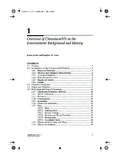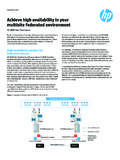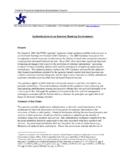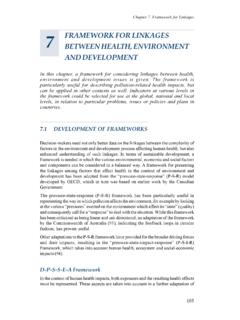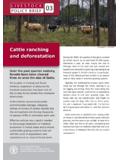Transcription of Diagnosing a firm's internal environment for …
1 Diagnosing a firm s internal environment forcorporate entrepreneurshipDonald F. Kuratkoa,*, Jeffrey S. Hornsbyb, Jeffrey G. CovinaaKelley School of Business, Indiana University, 1309 E. Tenth Street, Bloomington, IN 47405-1701, School of Management, University of Missouri Kansas City, Kansas City, MO 64110, The innovation imperativeToday, continuous innovation in terms of products,processes, and administrative routines and struc-tures is needed to compete effectively in the glob-al markets of the 21stcentury. Executives agree thatinnovation is the most important pathway for com-panies to accelerate their pace of change in theglobal environment .
2 Yet Apple questions how theBusiness Horizons (2014) 57, 37 47 Available online at ;Measurement; internal environment ;CorporateEntrepreneurshipAss essmentInstrument;Diagnostic toolsAbstract Apple, 3M, Procter & Gamble, and Google know the importance of aninternal environment supportive of innovative activity. But how is that environmentidentified or measured? As research on corporate entrepreneurial activity has evolved,numerous researchers have acknowledged the importance of internal organizationaldimensions to promoting and supporting an environment for innovation.
3 This researchhas identified five specific dimensions that are important determinants of an environ-ment conducive to entrepreneurial behavior: (1) top management support, (2) workdiscretion/autonomy, (3) rewards/reinforcement, (4) time availability, and (5) organi-zational boundaries. If an organization is serious about developing an internal envi-ronment conducive to entrepreneurial activity, then it must seek to measure thespecific dimensions associated with an innovative environment . In this article weintroduce an instrument, the Corporate Entrepreneurship Assessment Instrument(CEAI), as a diagnostic tool used for assessing managers perceptions of the five majordimensions critical to creating an entrepreneurial/innovative environment .
4 This in-strument provides an indication of a firm s likelihood of being able to successfullyimplement an innovative strategy, and highlights areas of the internal work environ-ment that should be the focus of ongoing development efforts.# 2013 Kelley School of Business, Indiana University. Published by Elsevier Inc. All rightsreserved.* Corresponding authorE-mail addresses: ( ( Hornsby), Covin)0007-6813/$ see front matter # 2013 Kelley School of Business, Indiana University. Published by Elsevier Inc. All rights of Steve Jobs will impact its internal environ-ment of innovation (Bedigian, 2011); 3M worksmightily to regain its former innovative heritage(Gunther, 2010); Procter & Gamble (P&G) developsa special division to cultivate innovations for tomor-row but still wonders how this translates to itsinternal environment (Brown & Anthony, 2011);and Google is contemplating various strategies forenhancing the innovative prowess of its workforce(Finkle, 2012).
5 It is clear that some of today s mostrecognized innovative companies are working over-time to figure out the challenge of sustaining aninnovative environment amidst constant , 3M, P&G, and Google are just four examplesof growing firms where the mantras are all toosimilar: sustain an internal environment of innova-tion in order to excel in the 21stcentury. These firmsand thousands of others realize there must be ele-ments within their organization that should be man-aged in order to enhance the innovative capacitiesof their managers. There are numerous writingsabout reward systems, management support, andmanagerial autonomy to encourage the innovativeenvironment.
6 But how are organizational leaderssupposed to gauge these elements?Corporate entrepreneurship a significant formof corporate innovation is envisioned to be a pro-cess that can facilitate firms efforts to innovateconstantly and cope effectively with the competi-tive realities companies encounter when competingin world markets. Leading strategic thinkers aremoving beyond the traditional product and serviceinnovations to pioneering innovation in processes,value chains, business models, and all functions ofmanagement (Govindarajan & Trimble, 2005).
7 Thus,corporate entrepreneurship and innovation are con-cepts that have captivated the interest of execu-tives in many corporate boardrooms (Morris,Kuratko, & Covin, 2011). All organizations are facingtimes requiring innovative vision, courage, calculat-ed risk-taking, and strong leadership. As Kuratko(2009) pointed out, organizations must realize theentrepreneurial imperative of the 21stcentury isnow at that exhibit corporate entrepreneurshipare typically viewed as dynamic, flexible entitiesprepared to take advantage of new business oppor-tunities when they arise (Kuratko, Goldsby, &Hornsby, 2012).
8 They explore new business domains,as well as new ways of conducting business withinexisting domains. Deviation from prior routines,strategies, business models, and operating environ-ments are typical modes of operation in theseinnovation-minded companies. In other words, cor-porate entrepreneurship flourishes in establishedfirms when individuals are free to pursue actionsand initiatives, regardless of the rules. As StevenBrandt of Stanford once said: Ideas come frompeople. Innovation is a capability of the many (Kuratko, 2014, p. 68).
9 Research has shown that there are uncontrollablefactors in the external environment which may berelated to entrepreneurial activity inside an organi-zation. For instance, hostile and technologicallysophisticated environments have been shown tobe conducive to developing and implementing acorporate entrepreneurial strategy (Bradley, Al-drich, Shepherd, & Wiklund, 2011; Chattopadhyay,Glick, & Huber, 2001). Hostile environments arecharacterized by such factors as high firm failurerates, intense competitive pressure, and price-based competition.
10 Technologically sophisticatedenvironments are characterized by such factors assignificant R&D investments, frequent product and/or process technology changes, and a reliance onsuperior technical personnel as key bases of compet-itive advantage (Bettis & Hitt, 1995). Ireland, Covin,and Kuratko (2009) argue that an organization s top-level managers should exhibit a strategic intentiontoward entrepreneurial activity for their firms tosuccessfully compete in such environments. This in-tention finds managers seeking methods under theircontrol that could enhance the organization s inter-nal environment for entrepreneurial the importance of an organization scommitment to the perpetuation of innovation as astrategy, Ireland et al.
